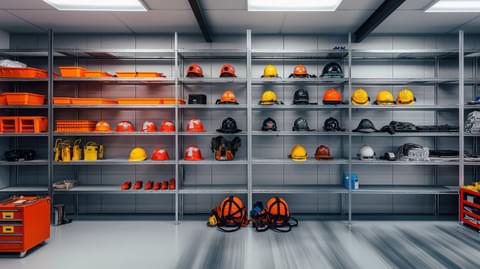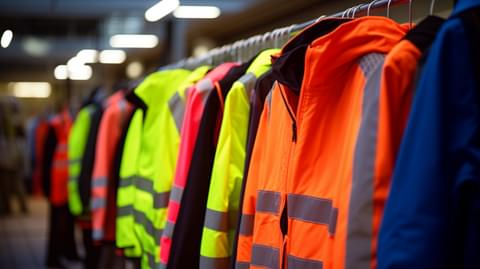Work with a trusted supplier
Correct PPE storage starts with sourcing quality equipment in the first place. When you work with a trusted supplier such as Tower, you can relax knowing your safety is in good hands.

Ensure optimum safety and longevity of your PPE with correct storage.
You’ve taken the time to purchase the correct PPE to protect your workers, but ensuring its effectiveness doesn’t stop there. Proper storage and maintenance of Personal Protective Equipment (PPE) is crucial to preserving its integrity and maintaining its lifespan.
To ensure maximum safety it is important you know the best practices for storing and caring for your PPE to maintain it to the highest standard, and ensure it remains in optimal condition. When you properly maintain and store your PPE you can have confidence that your equipment will continue to provide the necessary protection for your workforce.
Proper storage of Personal Protective Equipment (PPE) helps prevent it from getting damaged. By ensuring PPE is stored securely, you can maintain its condition and effectiveness, reducing the need for frequent replacements. Correct storage keeps the equipment away from any potential hazards that could cause damage and compromise its effectiveness.
Storing PPE correctly also reduces the risk of it falling from a height or becoming a trip hazard and causing injuries. Secure storage solutions help keep the workplace safe, preventing accidents that could harm employees.
Correct storage practices prevent damage to PPE, which in turn extends the longevity of the items. PPE items all have lifespans, but these will not be accurate if the equipment is not properly maintained. By keeping PPE in good condition, you can ensure it continues to provide adequate protection and, in return get the most value from your investment.
Proper storage is also crucial for items that may have been in contact with hazardous materials. Ensuring these items are stored correctly prevents them from contaminating other equipment or areas, maintaining a safe and healthy environment for all workers.

Proper storage of PPE is essential for the longevity of the items. Incorrect storage or maintenance can significantly reduce the lifespan of PPE, causing it to age well beyond its life expectancy. This not only leads to frequent replacements but also compromises the safety of those wearing the equipment. By ensuring the correct storage and maintenance of your equipment, you can prevent premature wear and tear, extend its usability and ensure it continues to provide reliable protection.
The lifespan of PPE varies depending on the type of equipment and how it is used, stored, and maintained. Ideally, work boots should last 6-12 months on the job, hard hats and ear defenders should last up to 3 years in their original packaging and up to 3 years in the workplace, and high-visibility clothing typically lasts about 6 months with regular use. However, these durations are heavily influenced by proper maintenance and storage practices. Without appropriate care, the actual lifespan of these items can be significantly reduced.
Understanding the expiration dates of PPE is crucial. These dates indicate the maximum lifespan of the equipment under ideal conditions, not necessarily the replacement date. Without proper care and storage, PPE may need to be replaced much sooner and if you're not aware of this, you may be compromising safety. Adhering to correct storage methods ensures that PPE remains effective until its expiration date.
Correct PPE storage starts with sourcing quality equipment in the first place. When you work with a trusted supplier such as Tower, you can relax knowing your safety is in good hands.

When it comes to storing PPE there are some general best practices that can be followed. A cool, dry, and clean environment free of contaminants is ideal for practically all types of PPE and is the basis for good storage.
Another good place to start is with specific manufacturer instructions that come with many PPE items. These clearly lay out the instructions for storage that you should adhere to.
Factors such as temperature control, humidity levels, and overall cleanliness play significant roles in maintaining the integrity of the equipment. Organisation is also key - designated storage areas with clear labels help in keeping the PPE orderly and easily accessible.
While these guidelines provide a general framework, it's important to note that storage requirements can vary depending on the type of equipment, so it is important to pay careful attention to each item's unique needs.
UV rays can degrade materials, reducing their effectiveness and lifespan.
Moisture can cause mold growth and material degradation, while high temperatures can warp or weaken materials.
Lack of airflow can lead to moisture buildup, promoting mold and mildew growth.
This can cause permanent creases, deformation, and damage to the protective properties of the materials.
Residual chemicals, dirt, and contaminants can degrade materials and reduce the effectiveness of the PPE.
Cross-contamination and physical damage can occur, especially if sharp or heavy items are stored with more delicate ones.
Exposure to contaminants can degrade materials and reduce the protective qualities of the PPE.
Potential damage or degradation may go unnoticed, leading to the use of ineffective PPE.
Lack of proper storage containers can lead to moisture buildup, contamination, and physical damage.
PPE should be kept in a dry, sanitary space that is easily accessible to workers, using shelves, storage cabinets, or lockers. It must be stored away from direct sunlight and UV sources, ideally in temperatures between 15 and 20 °C with humidity levels around 30-50%. Whenever possible, keep PPE in its original packaging to ensure it remains clean and uncontaminated. Following these tips will help preserve the quality and readiness of the equipment.

In the UK, it is a legal requirement for all employers to provide necessary storage for Personal Protective Equipment (PPE). According to the Workplace (Health, Safety and Welfare) Regulations 1992, employers are responsible for providing appropriate, secure, and adequate facilities for employees to store their PPE. These facilities can range from simple lockers in changing rooms to advanced options like special boxes that protect against dirt, temperature, and moisture.
Employers must also ensure that workers’ personal clothing is kept separate from wet or contaminated work gear and garments. Additionally, the Personal Protective Equipment at Work Regulations 1992 (PPER 1992) mandates that employers not only provide the required PPE but also maintain and store it properly. This includes keeping PPE clean, dry, and secure, ensuring it is always ready and safe for use.
While employers are responsible for the maintenance, storage, and replacement of any PPE they provide, workers have a duty to use the PPE properly, following the training and instructions given by their employer. This collaborative effort helps ensure a safe and compliant workplace.